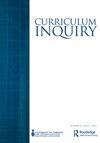让酷儿工作的混乱
IF 1.6
3区 教育学
Q2 EDUCATION & EDUCATIONAL RESEARCH
引用次数: 0
摘要
酷儿身份可能很混乱。不仅仅是作为对个人的描述,或者适用于一个社区,而是作为一种了解和存在的方式,它打破了二元对立,模糊了界限,并保持了矛盾(Campbell & Farrier, 2015;爱,2016年)。这些都是混乱的事情,因为他们不认为整洁,有组织和有纪律的思维方式是在学术界优先考虑的。虽然许多酷儿学者承认并经常庆祝他们主体性的混乱,这创造了知识生产和动员的新模式(love, 2016, p. 345),但更广泛的教育仍然在与如何处理酷儿问题作斗争。让“酷儿”发挥作用,意味着为酷儿和变性人及其社区的生活经历的(非)可能性、紧张和复杂性腾出空间,尊重他们在异性恋世界中导航的具体知识。当提到酷儿及其与教育的关系时,通常主要是通过反欺凌和身份框架来支持学生(Fields et al., 2014)。但我们的奖学金不仅仅是倡导lGBtQ群体的代表;它正在挑战教育赖以建立的基本假设。青少年无家可归是一个酷儿问题,无障碍也是一个酷儿问题,从学校到监狱的通道也是一个酷儿问题;教育及其与任何社会问题的交集都是奇怪的。作为教育工作者,我们能进行什么样的混乱对话,使用酷儿身份而不是代表政治?酷儿会产生什么样的可能性?我们怎样才能利用酷儿的混乱,不仅为教育领域的共同问题创造新的方法,而且挑战学术界的规范和假设,因为它继续着对酷儿和变性人的历史剥夺。在校园内外对lGBtQ人群的攻击越来越多的时代,反击针对酷儿和跨性别青年、他们的家庭和社区的持续贬低言论是很重要的。本期《课程探究》(CI)的文章关注酷儿认识论、理论和方法论是如何在教育环境中应用的,这些文章以为所有年轻人创造更具包容性的空间的方式,将酷儿问题放在了工作中。这些参与挑战了在异性恋者想象的逻辑中组织酷儿和跨性别主体性的“整洁”方式。作者超越了表象,阐明了酷儿是如何产生认知和存在的方式的,这种方式不仅肯定了身份,而且肯定了酷儿/跨性别群体的具体知识。本期《CI》中的文章共同揭示了其中的一些混乱本文章由计算机程序翻译,如有差异,请以英文原文为准。
The messiness of putting queerness to work
Queerness can be messy. Not just as a description of individual people, or as applied to a community, but rather as a way of knowing and being that disrupts binaries, blurs boundaries, and holds contradictions (Campbell & Farrier, 2015; love, 2016). these are all messy things, as they don’t ascribe to the neat, organized, and disciplined ways of thinking that are prioritized in the academy. While many queer scholars acknowledge and often celebrate the messiness of their subjectivity, which creates new modes of knowledge production and mobilization (love, 2016, p. 345), education more broadly still struggles with what to do with queerness. Putting queerness to work means making space for the (im)possibilities, tensions, and complexities of the lived experience of queer and trans people and their communities, honouring their embodied knowledge of navigating a cisheterosexist world. When queerness and its relationship to education is invoked, it is often primarily through the lens of anti-bullying and identity frameworks to support students (Fields et al., 2014). But queering our scholarship is more than advocating for representation of lGBtQ peoples; it is challenging the fundamental assumptions upon which education is built. Youth homelessness is a queer issue, accessibility is a queer issue, the school-to-prison pipeline is a queer issue; education and its intersection with any and every social issue is queer. as educators, what messy conversations can we have that use queerness beyond the politics of representation? What (im)possibilities might queerness produce? How can we use the messiness of queerness to not only create new approaches to the common issues within education, but also to challenge the norms and assumptions of the academy, as it continues with the historical disenfranchisement of queer and trans people. in a time with increasing attacks against lGBtQ people, both inside and outside of schools, it is important to push back against the ongoing disparaging rhetoric about queer and trans youth, their families, and their communities. drawing attention to how queer epistemologies, theories, and methodologies are applied across educational contexts, the articles in this issue of Curriculum Inquiry (CI) put queerness to work in ways that create more inclusive spaces for all young people. these engagements challenge the “neat” ways of organizing queer and trans subjectivity within the logics of the cisheterosexist imagination. the authors move beyond representation to illuminate how queerness produces ways of knowing and being that affirm not just the identities but the embodied knowledges of queer/trans communities. together, the articles in this issue of CI shed light on some of the messiness
求助全文
通过发布文献求助,成功后即可免费获取论文全文。
去求助
来源期刊

Curriculum Inquiry
EDUCATION & EDUCATIONAL RESEARCH-
CiteScore
3.10
自引率
17.60%
发文量
37
期刊介绍:
Curriculum Inquiry is dedicated to the study of educational research, development, evaluation, and theory. This leading international journal brings together influential academics and researchers from a variety of disciplines around the world to provide expert commentary and lively debate. Articles explore important ideas, issues, trends, and problems in education, and each issue also includes provocative and critically analytical editorials covering topics such as curriculum development, educational policy, and teacher education.
 求助内容:
求助内容: 应助结果提醒方式:
应助结果提醒方式:


